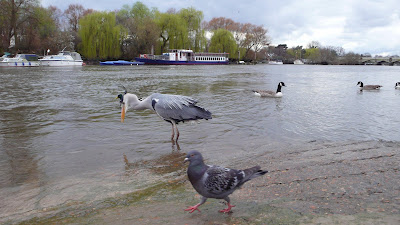These pictures are now a few weeks old, but I'll chuck them on here anyhow! There's a lot more to see considering Wiltshire is rather big and I always travel West to East (and vice versa) rather than North to South. I like Wiltshire though, because it's very,
very country, compared to neighbouring Berkshire. That said, Wiltshire also has some of the worst roads (especially with new potholes on the usual roads that have opened up since the snow and ice!). Still, this is my bit of Wiltshire along the A4.

Took Duke out on another big outing, this time with a few pictures of Calne, which is probably one of my favourite Wiltshire towns (the other being Marlborough) and lies on the edge of the Marlborough Downs. Calne has quite a number of stone buildings and has a prosperous history. Historically it is known for rearing pigs (on their way from Ireland, through Bristol and onto Smithfield Market in London) and also cloth. It's quite pretty!
This little bit of street is called Market street - Calne was once a market town.

The main street, Curzon Street:

This is St Mary's church, built in the 15th century from donations from clothiers and wool merchants:


Many of the buildings were built with stone in a yellow colour such as these:

This is the, rather elegant, Town Hall:

..and right next to it is a river or a canal - I can't tell and the map isn't clear.

About 3 miles east of Calne is the village of Cherhill. Cherhill is known for it's
White Horse - one of many across this region of the UK. It's not the oldest, and it's white colour is a result of the chalk which was restored in 2002 - I assume it was originally chalk before then. It was made in 1780, and although it has had an "eye" made from glass bottles which glistened in the sun on a few occasions, those have "disappeared" and is now made from stone and concrete. By now, the weather started getting a bit bad, it was getting dark and my phone's cradle setup was crackling due to the shaking from the handlebars.. so here is a MUCH better picture from a previous visit: (I don't know that guy on the motorbike, he just happened to be in it! =)

By now it's getting really bad for picture-taking, and we're now in the Marlborough Downs, but this is a building covered in vegetation with only the windows left uncovered in Beckhampton, another few miles further down.

Also in Beckhampton is one of the prettiest pubs I've seen - the Wagon and Horses. It gets it's name from being a coaching inn in the past for travellers stopping on journeys from London to Bath.
Dickens travelled this way in 1835 and wrote: "It was a comfortable-looking place. There was a strong cheerful light in the bar-window" in the Pickwick Papers. I also have a much nicer and not-so-gloomy picture of the pub, from a previous trip that dad took of me and mum, so here it is!:

Last stop before it really got too dark to take pictures... this is
Silbury Hill, an ancient man-made mound measuring 40 metres high. No one really knows what it was built for, but there is an overwhelming view of it as you come near from either direction of the A4. You can't help but wonder, "what an earth is that?" - I did! Not far from here is the village of Avebury, which has an ancient stone circle similar to Stonehenge, but on a much smaller scale. Perhaps I'll visit that in a month or two to get some nice pictures =)

... and that, is my bit of Wiltshire for this month!

























































